| Gunpowder From Wikipedia
Gunpowder, also called black powder, is a mixture of sulfur,
charcoal, and potassium nitrate. Gunpowder can be made just using potassium
nitrate and charcoal, but without the sulfur, the powder is not as strong.
It burns rapidly, producing a volume of hot gas made up of carbon dioxide,
water, and nitrogen, and a solid residue of potassium sulfide. Because
of its burning properties and the amount of heat and gas volume that it
generates, gunpowder has been widely used as a propellant in firearms and
as a pyrotechnic composition in fireworks. The term gunpowder also refers
broadly to any propellant powder. Modern firearms do not use the traditional
gunpowder (black powder) described in this article, but instead use smokeless
powder. Antique firearms or replicas of antique firearms are often used
with black powder substitute.
Gunpowder is classified as a low explosive because of
its relatively slow decomposition rate and consequently low brisance. Low
explosives deflagrate at subsonic speeds. High explosives detonate, producing
a supersonic wave. Ignition of the powder packed behind a bullet must generate
enough pressure to force it from the muzzle at high speed, but not enough
to rupture the gun barrel. Gunpowder is thus less suitable for shattering
rock or fortifications, where high explosives such as TNT are preferred.
Characteristics
The term black powder was coined in the late 19th century
to distinguish prior gunpowder formulations from the new smokeless powders
and semi-smokeless powders.(Semi-smokeless powders featured bulk volume
properties that approximated black powder in terms of chamber pressure
when used in firearms, but had significantly reduced amounts of smoke and
combustion products; they ranged in color from brownish tan to yellow to
white. Most of the bulk semi-smokeless powders ceased to be manufactured
in the 1920s.)
Black powder is a granular mixture of
* a nitrate, typically potassium nitrate
(KNO3), which supplies oxygen for the reaction;
* charcoal, which provides carbon
and other fuel for the reaction, simplified as carbon (C);
* sulfur (S), which, while also serving
as a fuel, lowers the temperature required to ignite the mixture, thereby
increasing the rate of combustion.
Potassium nitrate is the most important ingredient in
terms of both bulk and function because the combustion process releases
oxygen from the potassium nitrate, promoting the rapid burning of the other
ingredients. To reduce the likelihood of accidental ignition by static
electricity, the granules of modern black powder are typically coated with
graphite, which prevents the build-up of electrostatic charge.
Charcoal does not consist of pure carbon; rather, it consists
of partially pyrolyzed cellulose, in which the wood is not completely decomposed.
The current standard composition for the black powders
that are manufactured by pyrotechnicians was adopted as long ago as 1780.
Proportions by weight are 75% potassium nitrate (known as saltpeter or
saltpetre), 15% softwood charcoal, and 10% sulfur. These ratios have varied
over the centuries and by country, and can be altered somewhat depending
on the purpose of the powder. For instance, power grades of black powder,
unsuitable for use in firearms but adequate for blasting rock in quarrying
operations, is called blasting powder rather than gunpowder with standard
proportions of 70% nitrate, 14% charcoal, and 16% sulfur; blasting powder
may be made with the cheaper sodium nitrate substituted for potassium nitrate
and proportions may be as low as 40% nitrate, 30% charcoal, and 30% sulfur.
Combustion rate
The burn rate of black powder can be changed by corning.
Corning first compresses the fine black powder meal into blocks with a
fixed density (1.7 g/cm³). The blocks are then broken up into granules.
These granules are then sorted by size to give the various grades of black
powder. In the United States, standard grades of black powder run from
the coarse Fg grade used in large bore rifles and small cannons, through
FFg (medium and smallbore arms such as muskets and fusils), FFFg (smallbore
rifles and pistols), and FFFFg (extreme small bore, short pistols and most
commonly for priming flintlocks). In the United Kingdom, the gunpowder
grains are categorised by mesh size: the BSS sieve mesh size, being the
smallest mesh size on which no grains were retained. Recognised grain sizes
are Gunpowder G 7, G 20, G 40, and G 90.
A simple, commonly cited, chemical equation for the combustion
of black powder is
2 KNO3 + S + 3 C ? K2S + N2 + 3 CO2.
A more accurate, but still simplified, equation is
10 KNO3 + 3 S + 8 C ? 2 K2CO3 + 3 K2SO4
+ 6 CO2 + 5 N2.
The burning of gunpowder does not take place as a single
reaction, however, and the byproducts are not easily predicted. One study's
results showed that it produced (in order of descending quantities): 55.91%
solid products: potassium carbonate, potassium sulfate, potassium sulfide,
sulfur, potassium nitrate, potassium thiocyanate, carbon, ammonium carbonate.
42.98% gaseous products: carbon dioxide, nitrogen, carbon monoxide, hydrogen
sulfide, hydrogen, methane, 1.11% water.
Black powder made with sodium nitrate tends to be hygroscopic,
unlike black powders made from saltpeter. (In this article, "saltpeter"--also
spelled "saltpetre"--means potassium nitrate and not any of the other nitrates
that are also sometimes called "saltpeter.") Because black powder made
with saltpeter is less affected by moisture in the air, it can be stored
unsealed for centuries without degradation if it is kept dry. Muzzleloaders
have been known to fire after hanging on a wall for decades in a loaded
state, provided they remained dry. By contrast, black powder made with
sodium nitrate must be sealed from the moisture in the air to remain stable
for long periods.
Advantages
In firearms, black powder allows loading by volumetric
measure, whereas smokeless powder requires precise measuring of the charge
by weight to prevent damage due to overloading, though damage by overloading
is still possible with black powder.
In quarrying, high explosives are generally preferred
for shattering rock. However, because of its low brisance, black powder
causes fewer fractures and results in more usable stone compared to other
explosives, making black powder useful for blasting monumental stone such
as granite and marble.
Black powder is well suited for blank rounds, signal flares,
burst charges, and rescue-line launches. Black powder is also used in fireworks
for lifting shells, in rockets as fuel, and in certain special effects.
Disadvantages
Black powder has low energy density compared to modern
smokeless powders and produces a thick smoke that can impair aiming and
reveal a shooter's position.
Combustion converts less than half the mass of black powder
to gas. The rest ends up as a thick layer of soot inside the barrel. In
addition to being a nuisance, the residue from burnt black powder is hygroscopic
and an anhydrous caustic substance. When moisture from the air is absorbed,
the potassium oxide or sodium oxide turns into hydroxide, which will corrode
wrought iron or steel gun barrels. Black powder arms must be well cleaned
both inside and out to remove the residue. The Matchlock musket (an early
gun) would be unusable in wet weather due to powder in the pan being exposed
and dampened, in which case soldiers would use the ends as clubs or use
bayonets.
Transportation
The UN Model Regulations on the Transportation of Dangerous
Goods and national transportation authorities, such as United States Department
of Transportation, have classified Gunpowder (black powder) as a Group
A: Primary explosive substance for shipment because it ignites so easily.
Complete manufactured devices containing black powder are usually classified
as Group D: Secondary detonating substance, or black powder, or article
containing secondary detonating substance, such as firework, class D model
rocket engine, etc., for shipment because they are harder to ignite than
loose powder. As explosives, they all fall into the category of Class 1.
Energy content
Gunpowder contains 3 megajoules per kilogram, and contains
its own oxidant. For comparison, the energy density of TNT is 4.6 megajoules
per kilogram, and the energy density of gasoline is 47.2 megajoules per
kilogram.
Sulfur-free gunpowder
The development of smokeless powders, such as Cordite,
in the late 19th century created the need for a spark-sensitive priming
charge, such as gunpowder. However, the sulfur content of traditional gunpowders
caused corrosion problems with Cordite Mk I and this led to the introduction
of a range of sulfur-free gunpowders, of varying grain sizes. They typically
contain 70.5 parts of saltpetre and 29.5 parts of charcoal. Like black
powder, they were produced in different grain sizes. In United Kingdom,
the finest grain was known as sulfur-free mealed powder (SMP). Coarser
grains were numbered as sulfur-free gunpowder (SFG n): 'SFG 12', 'SFG 20',
'SFG 40' and 'SFG 90', for example; where the number represents the smallest
BSS sieve mesh size on which no grains were retained.
The main purpose of sulfur in gunpowder is to decrease
the ignition temperature. A sample reaction for sulfur-free gunpowder would
be
4 KNO3 + C7H8O ? 3 K2CO3 + 4 CO2 +
2 H2O + 3 N2
History
A Mongol bomb thrown against a charging Japanese samurai
during the Mongol invasions of Japan after founding the Yuan Dynasty, 1281.
Main article: History of gunpowder
Gunpowder was invented, documented, and used in ancient
China where the Chinese military forces used gunpowder-based weapons technology
(i.e. rockets, guns, cannons), and explosives (i.e. grenades and different
types of bombs) against the Mongols when the Mongols attempted to invade
and breach the Chinese city fortifications on the northern borders of China.
After the Mongols conquered China and founded the Yuan Dynasty, they used
the Chinese gunpowder-based weapons technology in their invasion of Japan.
Chinese also used gunpowder to fuel rockets. However, it has also been
argued that, like the wheel, gunpowder was "coinvented" or "co-discovered"
prior to, simultaneously or slightly after the Chinese, by cultures separated
from the Chinese by vast distances, with minimal direct contact between
one another.
A major problem compounding unbiased academic study is
rapid access to original sources. Moreover, the major dilemma of accurate
transliteration of original sources, especially of medieval Chinese texts,
from then-understood metaphor and/or prose employed to describe (then)
hitherto unexplained phenomena into contemporary languages with their well-established
and rigidly defined terminology. The difficulty in transliteration lends
itself readily to errors or latitude bordering on artistic licence in the
interpretation
An evaluation of all arguments and thorough literature
review is beyond the scope of this article. Rather than take a position,
the article will present all arguments to the reader. |
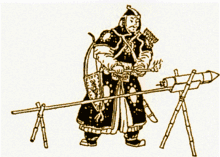
Early Chinese rocket
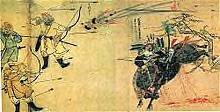
A Mongol bomb thrown against a charging
Japanese samurai during the Mongol
invasions of Japan after founding the
Yuan Dynasty, 1281.
|
China

Chinese Ming Dynasty (1368-1644 AD)
matchlock firearms |
Saltpeter was known to the Chinese by the mid-1st century
AD and there is strong evidence of the use of saltpeter and sulfur in various
largely medicinal combinations. A Chinese alchemical text dated 492 AD
noted saltpetre burnt with a purple flame, providing a practical and reliable
means of distinguishing it from other inorganic salts, thus enabling alchemists
to evaluate and compare purification techniques. The Chinese word for "gunpowder"
is Chinese: ??/??; pinyin: hu? yào /xuou y??/, which literally means
"Fire Medicine."
The first reference of gunpowder is possibly the passage
of the Zhenyuan miaodao yaolüe, a Taoist text tentatively dated to
the mid-800s CE: |
Some have heated together sulfur, realgar and saltpeter
with honey; smoke and flames result, so that their hands and faces have
been burnt, and even the whole house where they were working burned down.
By the 9th century Taoist monks or alchemists searching
for an elixir of immortality had serendipitously stumbled upon gunpowder.
The Chinese "Wu Ching Tsung Yao", written by Tseng Kung-Liang
in 1044, provides encyclopedia references to a variety of mixtures which
included petrochemicals, as well as garlic and honey. A slow match for
flame throwing mechanisms using the siphon principle and for fireworks
and rockets are mentioned. Academics argue the Chinese wasted little time
in applying gunpowder to warfare, and they produced a variety of gunpowder
weapons, including flamethrowers, rockets, bombs, and mines, before inventing
guns as a projectile weapon.
Middle East
Main articles: Inventions in the Islamic world and Alchemy
and chemistry in Islam
The Arabs acquired knowledge of gunpowder some time after
1240 AD, but before 1280 AD, by which time Hasan al-Rammah had written,
in Arabic, recipes for gunpowder, instructions for the purification of
saltpeter, and descriptions of gunpowder incendiaries. However, because
al-Rammah attributes his material to "his father and forefathers", al-Hassan
argues that gunpowder became prevalent in Syria and Egypt by "the end of
the twelfth century or the beginning of the thirteenth". |
.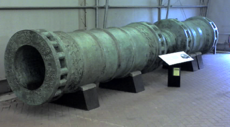
The Sultani Cannon, a very heavy bronze
muzzle-loading cannon of type used by
Ottoman Empire in the siege of
Constantinople, 1453 AD. |
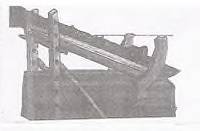 . .
A picture of a 15th century Granadian
cannon from the book Al-izz wal rifa'a. |
Al-Hassan claims that in the Battle of Ain Jalut of 1260
AD, the Mamluks used against the Mongols in "the first cannon in history"
gunpowder formulæ with near-identical ideal composition ratios for
explosive gunpowder. However, Khan claims that it was invading Mongols
who introduced gunpowder to the Islamic world and cites Mamluk antagonism
towards early riflemen in their infantry as an example of how gunpowder
weapons were not always met with open acceptance in the Middle East. Similarly,
the refusal of their Qizilbash forces to use firearms contributed to the
Safavid rout at Chaldiran in 1514. |
The earliest surviving documentary evidence for the use
of the hand cannon, considered the oldest type of portable firearm and
a forerunner of the handgun, are from several Arabic manuscripts dated
to the 14th century. Al-Hassan argues that these are based on earlier originals
and that they report hand-held cannons being used by the Mamluks at the
Battle of Ain Jalut in 1260.
Hasan al-Rammah included 107 gunpowder recipes in his
text al-Furusiyyah wa al-Manasib al-Harbiyya (The Book of Military Horsemanship
and Ingenious War Devices), 22 of which are for rockets. If one takes the
median of 17 of these 22 compositions for rockets (75% nitrates, 9.06%
sulfur, and 15.94% carbon), it is near identical with the modern reported
ideal gunpowder recipe of 75% potassium nitrate, 10% sulfur, and 15% carbon,
although this was already known to Roger Bacon
Mainland Europe
C. F. Temler interprets Peter, Bishop of Leon, as reporting
the use of cannon in Seville in 1248 AD.
In Norwegian the Konungs skuggsjá of 1250 AD mentions
in its military chapter, the use of two key ingredients: "coal and sulphur"
as the best weapons for ship-to-ship combat.
Dated around 1257 AD, among the earliest extant written
references to gunpowder in Europe, are Roger Bacon's texts Epistola, "De
Secretis Operibus Artis et Naturae et de Nullitate Magiae," dated variously
between 1248 and 1257, he states:
| We can, with saltpeter and other substances, compose
artificially a fire that can be launched over long distances... By only
using a very small quantity of this material much light can be created
accompanied by a horrible fracas. It is possible with it to destroy a town
or an army ... In order to produce this artificial lightning and thunder
it is necessary to take saltpeter, sulfur, and Luru Vopo Vir Can Utriet. |
| The last part has been interpreted as an elaborate coded
anagram for the quantities needed, but other academics holding contrary
viewpoints argue this may be erroneous transcription of a passage read
with much difficulty.
Some authors maintain that around 1261, Roger did develop
the ideal formula for gunpowder
(75% of saltpeter, 15% of carbon and 10% of sulphur)
In the Opus Maior of 1267 AD, Bacon describes firecrackers:
| a child’s toy of sound and fire and explosion made in
various parts of the world with powder of saltpetre, sulfur and charcoal
of hazelwood. |
|
.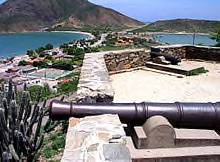
Cannons forged in 1667 AD at the
Fortín de La Galera, Nueva Esparta,
Venezuela. |
The Liber Ignium, or Book of Fires, attributed to Marcus
Graecus, is a collection of incendiary recipes, including some gunpowder
recipes. Partington dates the gunpowder recipes to approximately 1300.
One recipe for "flying fire" (ingis volatilis) involves saltpetre, sulfur,
and colophonium, which, when inserted into a reed or hollow wood, "flies
away suddenly and burns up everything." Another recipe, for artificial
"thunder", specifies a mixture of one pound native sulfur, two pounds linden
or willow charcoal, and six pounds of saltpeter. Another specifies a 1:3:9
ratio.
Some of the gunpowder recipes of De Mirabilibus Mundi
of Albertus Magnus are identical to the recipes of the Liber Ignium, and
according to Partington, "may have been taken from that work, rather than
conversely." Partington suggests that some of the book may have been compiled
by Albert's students, "but since it is found in thirteenth century manuscripts,
it may well be by Albert." Albertus Magnus died in 1280 AD.
A common German folk-tale is of the German priest/monk
named Berthold Schwarz who independently invented gunpowder, thus earning
it the German name Schwarzpulver or in English Schwarz's powder. Schwarz
is also German for black so this folk-tale, while likely containing elements
of truth, is considered problematic.
The major and uniquely European advancement of gunpowder
was corning: the addition of moisture to the gunpowder to form regular
greater grains which much increased the reliability and consistency of
gunpowder. This occurred around the late 1400s AD, as European powdermakers
began adding moisture to gunpowder to reduce dust and with it the risk
of dust explosion. The powdermakers would then shape the resulting mush
of dampened gunpowder, known as mill cake, into corns, or grains, to dry.
The new "corned" powder remained potent and more reliable
to store as it was far less hygroscopic than the former powder (due to
net reduced surface area). Gunners also found it was more powerful and
easier to load measures of it into guns. The main advantage of corning
is that the combustion flame spreads evenly between the grains, thus igniting
all grains before significant gas expansion (when the gunpowder actually
"explodes"). Gunpowder not corned results in much unburnt powder blown
away from the ignition flame and combustion chamber due to localized miniature
gas expansions within the powder.
Europeans innovated by experimentation and discovering
different kernel sizes combusted at differing rates, and thus were more
suitable for one gun or for another. Otto notes that without corning, gunpowder
like all dry mixtures, has a tendency to gradually demix back into its
original components and thus too unreliable for effective use in guns as
mixtures would not be of uniform composition, noting the use of corning
technique is commonplace in the modern pharmaceutical industry to ensure
uniform proportions of active ingredients for each tablet.
Shot and gunpowder for military purposes were made by
skilled military tradesmen, later called firemakers, and were also required
to craft fireworks for celebrations of victory or peace. During the Renaissance,
two European schools of pyrotechnic thought emerged, one in Italy and the
other at Nürnberg, Germany. The Italian school of pyrotechnics emphasized
elaborate fireworks, and the German school stressed scientific advancement.
Both schools added significantly to further development of pyrotechnics,
and by the mid-17th century fireworks were used for entertainment on an
unprecedented scale in Europe, being popular even at resorts and public
gardens.
By 1788, as a result of the reforms for which Lavoisier
was mainly responsible, France had become self-sufficient in saltpeter,
and its gunpowder had become not only widely considered the best in Europe
but more importantly, inexpensive.
The introduction of smokeless powder in the late 19th
century led to the contraction of the gunpowder industry
British Isles
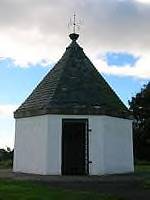
The old Powder or Pouther
magazine dating from 1642 AD,
built by order of James VI.
Irvine, North Ayrshire,
Scotland. |
By the early fourteenth century, according to N.J.G.
Pounds's study The Medieval Castle in England and Wales, many English castles
had been deserted and others were crumbling. Their military significance
faded except on the borders. Gunpowder made smaller castles useless.
Henry VIII of England was short of gunpowder when he invaded
France in 1544 AD and England needed to import gunpowder via the port of
Antwerp.
The English Civil War, 1642-1645 AD, led to an expansion
of the gunpowder industry, with the repeal of the Royal Patent in August
1641.
Gunpowder production in England appears to have started
in the mid 13th century AD with the aim of supplying The Crown. Records
show that gunpowder was being made, in England, in 1346, at the Tower of
London; a powder house existed at the Tower in 1461; and in 1515 three
King's gunpowder makers worked there. Gunpowder was also being made or
stored at other Royal castles, such as Portchester Castle.
The introduction of smokeless powder in the late 19th
century led to a contraction of the gunpowder industry. After the end of
World War I, the majority of the United Kingdom gunpowder manufacturers
merged into a single company, "Explosives Trades limited"; and number of
sites were closed down, including those in Ireland. This company became
Nobel Industries Limited; and in 1926 became a founding member of Imperial
Chemical Industries. The Home Office removed gunpowder from its list of
Permitted Explosives; and shortly afterwards, on 31 December 1931, the
former Curtis & Harvey's Glynneath gunpowder factory at Pontneddfechan,
in Wales, closed down, and it was demolished by fire in 1932.
|
| The last remaining gunpowder mill at the Royal Gunpowder
Factory, Waltham Abbey was damaged by a German parachute mine in 1941 and
it never reopened. This was followed by the closure of the gunpowder section
at the Royal Ordnance Factory, ROF Chorley, the section was closed and
demolished at the end of World War II; and ICI Nobel's Roslin gunpowder
factory which closed in 1954.
This left the sole United Kingdom gunpowder factory at
ICI Nobel's Ardeer site in Scotland; it too closed in October 1976. Since
then gunpowder has been imported into the United Kingdom. In the late 1970s
/ early 1980s gunpowder was bought from eastern Europe, particularly from
what was then the East Germany and former Yugoslavia. |
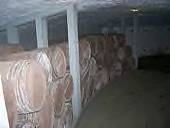
gun powder storing barrels at
Martello tower in Point Pleasant Park |
India
Gunpowder had arrived in India by the mid-1300s, perhaps
introduced by the Mongols as early as the mid-1200s.
It was written in the Tarikh-i Firishta (1606–1607) that
the envoy of the Mongol ruler Hulegu Khan was presented with a dazzling
pyrotechnics display upon his arrival in Delhi in 1258 CE. Firearms known
as top-o-tufak also existed in the Vijayanagara Empire of India by as early
as 1366 AD. From then on the employment of gunpowder warfare in India was
prevalent, with events such as the siege of Belgaum in 1473 AD by Sultan
Muhammad Shah Bahmani. |
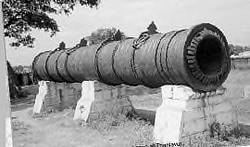
A 17th century forge-welded iron cannon,
at Thanjavur's eastern entrance (India). |
By the 16th century, Indians were manufacturing a diverse
variety of firearms; large guns in particular, became visible in Tanjore,
Dacca, Bijapur and Murshidabad. Guns made of bronze were recovered from
Calicut (1504 AD) and Diu (1533 AD). Gujar?t supplied Europe saltpeter
for use in gunpowder warfare during the 17th century. Bengal and M?lwa
participated in saltpeter production. The Dutch, French, Portuguese, and
English used Ch?pra as a center of saltpeter refining.
War rockets, mines and counter mines using gunpowder were
used in India by the time of Akbar and Jahangir. Fathullah Shirazi (c.
1582), a Persian-Indian polymath and mechanical engineer who worked for
Akbar the Great in the Mughal Empire, invented an autocannon, early multi-shot
gun. As opposed to the polybolos and repeating crossbows used earlier in
ancient Greece and China, respectively, Shirazi's rapid-firing gun had
multiple gun barrels that fired hand cannons loaded with gunpowder.
Both Hyder Ali and his son Tippu Sultan used black powder
technology in iron-cased war rockets with considerable effect against the
British, which inspired the development of the Congreve rocket.
Indonesia
The Javanese Majapahit Empire is argued to have grown
to span most of modern day ASEAN due to its Javanese mastery of bronze-smithing
and unique within the immediate region to the Majapahit court, the technology
and mass manufacture (via cottage industries which contributed to a central
arsenal). Documentary and archeological evidence indicate that Arab or
Indian traders introduced gunpowder, gonnes, muskets, blunderbusses, and
cannon to the Javanese, Acehnese, and Batak via long established commercial
trade routes around the early to mid 1300s CE. Early European aggressors
of Portugal and Spain were unpleasantly surprised and outgunned on many
occasions. The resurgent Singhasari Empire overtook Sriwijaya and later
emerged as the Majapahit who rigidly established fire-arms and cannonade
as a feature of warfare.
Circa 1540 CE the Javanese always alert for new weapons
found the newly arrived Portuguese weaponry superior to that of the locally
made variants. The Javanese bronze breech-loaded swivel-gun, erroneously
termed the lantaka, more correctly known as a meriam was used ubiquitously
by the Majapahit navy and unfortunately pirates and rival lords. The demise
of the Majapahit empire and the flight of disaffected skilled bronze cannon-smiths
to Brunei, modern Sumatra and Malaysia, and the Philippines lead to near
universal use of the swivel-gun, especially on trade vessels to protect
against prevalent marauding pirates, especially in the Makassar Strait.
A Chinese pirate or commercial shipwreck site unearthed
a double-ended swivel gun, which enabled swift firing: one barrel would
fire whiles its opposite would be reloaded, though this is a rare and unique
piece. Other archeological finds have unearthed some triple-barrel and
some double-barrel swivel-guns, which were not widely duplicated.
The saltpetre harvesting was recorded by Dutch and German
travelers as being common to even the smallest villages and collected from
the decomposition process of large goat dung hills specifically piled for
collection this saltpetre, a most unpleasant job. Saltpetre must be remembered
by today's reader as being a key food preservative agent in a period of
no refrigeration.
The Dutch punishment for possession of unpermitted gunpowder
appears to have been amputation.
Ownership and manufacture of gunpowder was later prohibited
by the colonial Dutch occupiers. Sir Thomas Stamford Raffles, from his
The History of Java relates the process of powder manufacture, perhaps
of noteworthy relevance considering at the time it was a military-related
craft and not always recorded:
the best sulphur is supplied from a
crater from a mountain near the straits of Bali...in caverns in irregularly
formed beds of earth, which being impregnated with the native nitre, saturated
with the evacuation of the enumerous bats that haunt these caves is mixed
with a compound of wood ashes, supplies the liquid that is boiled in large
kettles and afterward left to cool and crystallize.
Manufacturing technology
| For the most powerful black powder meal, a wood charcoal
is used. The best wood for the purpose is Pacific willow, but others such
as alder or buckthorn can be used. The ingredients are mixed as thoroughly
as possible. This is achieved using a ball mill with non-sparking grinding
apparatus (e.g., bronze or lead), or similar device. Historically, a marble
or limestone edge runner mill, running on a limestone bed was used in Great
Britain; however, by the mid 19th century AD this had changed to either
an iron shod stone wheel or a cast iron wheel running on an iron bed. The
mix is sometimes dampened with alcohol or water during grinding to prevent
accidental ignition.
Around the late 14th century AD, European powdermakers
began adding damp to the constituents of gunpowder to reduce dust and with
it the risk of explosion. The powdermakers would then shape the resulting
paste of dampened gunpowder, known as mill cake, into corns, or grains,
to dry. Not only did corned powder keep better because of its reduced surface
area, gunners also found that it was more powerful and easier to load into
guns. Before long, powdermakers standardized the process by forcing mill
cake through sieves instead of corning powder by hand. |
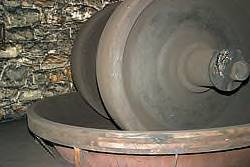
Edge-runner mill in a restored mill,
at Eleutherian Mills |
During the 18th century gunpowder factories became increasingly
dependent on mechanical energy.
Other uses
Besides its habitual use as an explosive, gunpowder has
been occasionally employed for other purposes, After the battle of Aspern-Essling
(1809), the surgeon of the Napoleonic Army Larrey combated the lack of
food for the wounded under his care by preparing a bouillon of horse meat
seasoned with gunpowder for lack of salt. It was also used for sterilizing
on ships when there was no alcohol.
Christiaan Huygens experimented with gunpowder in 1673
in an early attempt to build an internal combustion engine. He did not
succeed in making a practical engine.
Fireworks and Firecrackers also use gunpowder but use
different brands and different chemicals.
Black powder is still used in delay-trains in modern arms.
For instance, in a hand grenade, a mechanical striker ignites a percussion
primer which ignites a slow black powder delay. The delay burns a few seconds
until it gets to the high explosive primary, which detonates, initiating
the grenade fill explosive, thus fragmenting the grenade.
|